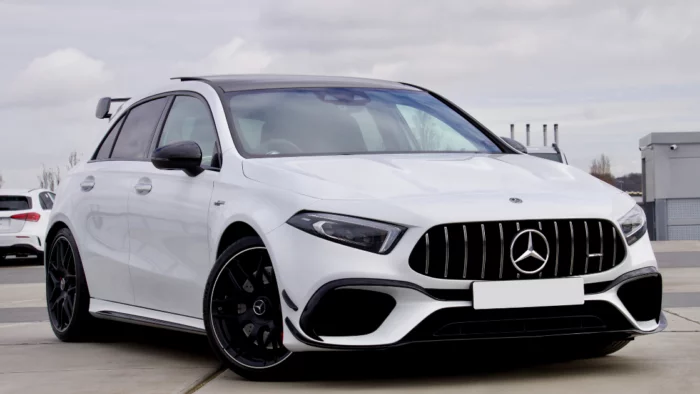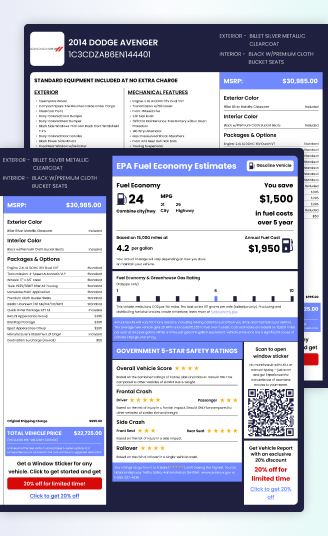Window stickers are great ways to show the specifications and features of used vehicles at dealerships. This brings us to the question, “Why do auto dealers place window stickers on the vehicles they sell?” These vehicles could be sold with or without window stickers. So why put them up?
What is a dealer window sticker?
A dealer window sticker is a label that displays specific information about the used vehicle.
This label is usually attached to a vehicle by its manufacturer, and it displays information such as the manufacturer’s suggested retail price, the car’s standard and optional equipment, fuel economy, safety ratings, and more.
It also includes the vehicle identification number (VIN) and the name of the manufacturer. This label is usually affixed to the new vehicle until it is sold.
After these vehicles have been used and sold to dealerships, there is a need to attach dealer window stickers to them.
They essentially assist the dealer in selling the vehicle, as they speak volumes about the vehicle’s specifications, features, fuel economy, emissions ratings, and more.
What Information Can You Find on an Auto Dealer's Window Sticker?
If you have taken a close look at a window sticker, you will notice that there is a lot of information contained in that little label.
Some of the details you would find on a dealer window sticker include
1. Manufacturer’s suggested retail price (MSRP)
Every new vehicle comes with a suggested retail price from the manufacturer. This is the price that is recommended by the manufacturer for the vehicle to be sold by the dealer to consumers.
READ ALSO: When Will Used Car Prices Drop? Few Things Car Shoppers Should Know
2. Standard and optional equipment
Included in the window sticker are the standard and optional equipment. It displays a list of the car options and features that come with the vehicle, such as air conditioning, navigation, and others.
3. Fuel economy
The fuel economy is another piece of information contained in a window sticker. It includes the vehicle’s MPG (miles per gallon) rating for city and highway driving.
4. Safety ratings
Safety ratings or awards received by the vehicle from organizations such as the National Highway Traffic Safety Administration (NHTSA) or the Insurance Institute for Highway Safety (IIHS) are tagged and included in a window sticker.
5. Vehicle identification number (VIN)
The VIN number of the vehicle can also be found on a window sticker. It is a unique 17-character string of letters and numbers that can be used to uncover major information about the vehicle’s history. This is done by generating a vehicle history report from companies offering VIN checks such as “Detailed Vehicle History,” “Instant VIN,” “Premium VIN,” “Vehicles Report,” and others.
6. Manufacturer’s name and contact information
This piece of information is just there for you if, for any reason, you want to reach out to the manufacturer. The contact information may be an address or a phone number.
7. Destination and delivery charge
The destination charge is usually a fee covering the cost of delivering a vehicle from the manufacturer to the dealer. If you are purchasing a new vehicle from a dealer, then you may have to pay this fee, but if it is a used vehicle, it may not apply to you.
8. Emissions information and ratings
If an emissions test has been carried out for your vehicle, this information will be included in the window sticker.
9. Warranty Information
Does the vehicle have a three-year warranty? Maybe a 100,000-mile warranty? With the warranty information attached to the window sticker, the warranty information can be discovered at a glance.
10. Dealer Information
This includes the name and contact information of the dealership that is selling the vehicle and any additional information that the dealership may want to include, such as financing options or special promotions.
This information is usually attached to custom window stickers. Some other information you can find on a car dealer window sticker includes
- Dealer-added options or packages
- Rebates and incentives
- Color and trim level
- Certifications
- Environmental impact
- Engine, transmission, and drivetrain information
- Towing and payload capacity
- Dimensions
- Curb weight
- Production date
The Legal Requirements for Window Stickers on Cars Sold by Auto Dealers
Did you know that there are legal requirements for window stickers on cars sold by auto dealers? According to the law, the label must be put on new and used vehicles in accordance with the Automobile Information Disclosure Act of 1958.
The law refers to the window sticker as the “buyer’s guide” and requires it to be placed on the vehicle to aid buyers in selecting the vehicle they need according to the features they see. If a dealership lacks window stickers on their vehicles, that dealership may be tagged as misleading.
Detailed Vehicle History offers a dealership program that focuses on providing window stickers and vehicle history reports of the best quality for dealers.
One product that makes Detailed Vehicle History (DVH) stand out is its classic window sticker lookup tool.
This means a window sticker for a classic vehicle can be generated with DVH’s classic window sticker tool.
Why Auto Dealers Use Window Stickers to Market Their Vehicles
Now that we have understood the basics of a window sticker and what it contains, let’s understand why auto dealers place window stickers on the vehicles they sell.
These dealers place original dealer window stickers for several brands, such as BMW dealer window stickers, Ford dealer window stickers, and others, and they do it for several reasons. Some of these reasons are
1. Legal requirement
As earlier mentioned, the federal government has made window stickers a legal requirement before vehicles can be sold. The law requires a window sticker to be displayed on every vehicle a dealership displays.
This enables consumers to have access to accurate and consistent information about the vehicles they are considering purchasing.
This information may include the MSRP, interior and exterior features of the vehicle, safety ratings, and other important information.
2. Transparency
Window stickers provide transparency for consumers, as all features are listed before their eyes.
With these features, they can compare various models, brands, and trim levels and select the best vehicle that suits their requirements.
READ ALSO: How to Check ATV VIN Number
3. Highlighting features
With window stickers, auto dealers can highlight the features and benefits of vehicles displayed for sale.
If a consumer strolls into the dealership with a particular model and particular features in mind, window stickers can quickly and easily highlight these details and present them to the consumer.
4. Competitive advantage
By using custom window stickers, auto dealers can differentiate their vehicles from those of their competitors and attract customers who are in need of a specific brand of a vehicle with specific trims and features.
This also helps with branding and promotion. The window sticker can be used to promote the brand of the vehicle, as well as the dealership.
4. Cost-effective
Window stickers from Detailed Vehicle History are an extremely cost-effective way for auto dealers to market their vehicles.
Attaching window stickers to vehicles does not require as much money as other forms of advertising. Instead, a dealer can market his window sticker for a small price.
In summary, auto dealers place window stickers on the vehicles they sell for various reasons.
It may be because window stickers are a cost-effective means of advertising their vehicles or because it gives them a competitive advantage over their competitors.
Whatever the reason, window stickers are necessary for new vehicles and even used vehicles. Make sure you get a window sticker from Detailed Vehicle History today.










